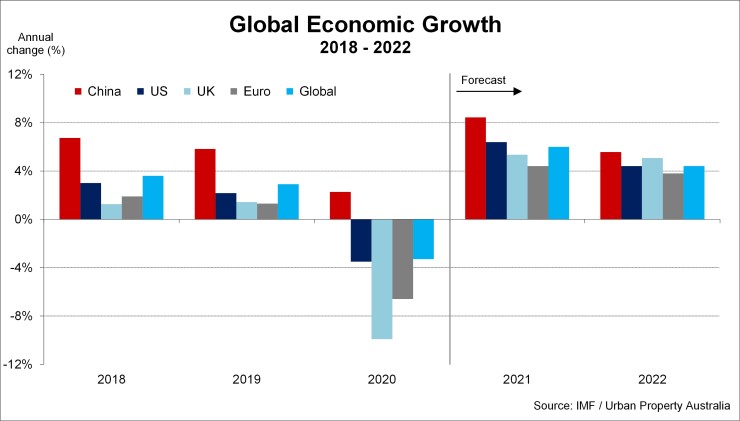Q2 2021 – Global Economic Overview
August 2nd 2021 | , Urban Property Australia
Q2 2021 – Global Economic Overview
According to the IMF, the global economy is projected to grow 6.0% in 2021 and 4.9% in 2022 with economic prospects of individual countries and regions divergent largely as a result of vaccine access and policy support. However, smooth and durable recoveries are not assured even in places where infections are seemingly under control. Close to 40% of the population in advanced economies has been fully vaccinated, compared with less than 10% in emerging market economies and a tiny fraction in low-income countries.
The GDP of Australia’s major trading partners is expected to grow by around 7% in 2021 and by 4.5% in 2022.
Household spending over the past year has necessarily focused on the purchase of goods (as opposed to services), which has meant those countries producing manufactured output have (generally) seen a sharper recovery than countries that have an industrial structure biased towards services.
The unprecedented convulsion in the global economy last year continues to trigger aftershocks that weigh on the recovery in some parts of the world. Empty shipping containers have been stranded in less frequented ports alongside shortages on busier routes, contributing to increased delivery times.

United States
The US economy is expected to recover fastest of the G7 economies because of its extensive fiscal support and rapid vaccination rollout. As a result of the Biden administration’s proposed spending plans, the IMF raised its U.S. outlook again, with economic growth projections of 7.0% in 2021 followed by 4.9% in 2022. Boosted by the substantial direct payments to households since December, goods consumption has remained strong and services consumption has started to recover. Unlike in most other economies, business investment in the United States has rebounded to above pre-pandemic levels as businesses plan for growth in domestic demand.
China
The China economy continues to strengthen from rising goods trade with the Chinese economy having outperformed the rest of world during the pandemic crisis, achieving remarkable growth of 2.3% over 2020 after experiencing a 10% contraction in the first quarter of 2020. While China has experienced one of the strongest economic recoveries globally, renewed outbreaks of COVID-19 temporarily weighed on growth in parts of the economy. Investment in infrastructure and real estate also continued to grow, supporting an increase in steel production and demand for iron ore imports, including from Australian producers who are the largest suppliers to China.
Europe
Despite a willingness to lockdown individual regions and cities across Europe, the transmission of Covid-19 across Europe has been exacerbated by the Schengen Agreement, which allows for the continuation of the free movement of people across the region. From an individual country perspective, Portugal, Spain, Greece, Italy and France have experienced a larger negative impact as a consequence of the pandemic primarily because of their relatively higher reliance on tourism. Until an effective vaccine is rolled out in large enough numbers, restrictions on international travel will remain, curtailing global services trade (especially in tourism) and therefore economic growth.
United Kingdom
The United Kingdom has been hit particularly hard by the coronavirus pandemic, both in terms of the health outcomes on its population as well as the consequences on its economy. The economic fallout of this pandemic on the UK economy has been severe. Having contracted by almost 10% in 2020, the economy is forecast to increase by 7.0% in 2021. After more than nine months of arduous negotiations the United Kingdom (UK) and the European Union (EU) finally struck a deal on their post Brexit trade relationship which essentially establishes a free trade zone between the two jurisdictions.
India
India is experiencing a new wave of infections and activity will decline over the near term. India is experiencing a rapid increase in COVID-19 cases. In the worst-affected states, authorities have imposed curfews and partial lockdowns. At this stage, the restrictions are targeted at curbing service-sector activity in hospitality, tourism and transportation, with manufacturing and construction activity less affected. Over the medium term, the government’s commitment to raise infrastructure investment and continued urbanisation should support Indian economic growth and demand for commodities.
Copyright © 2021 by Urban Property Australia All rights reserved. No part of this publication may be reproduced in any form, by microfilm, xerography, electronically or otherwise, or incorporated into any information retrieval system, without the written permission of the copyright owner.



